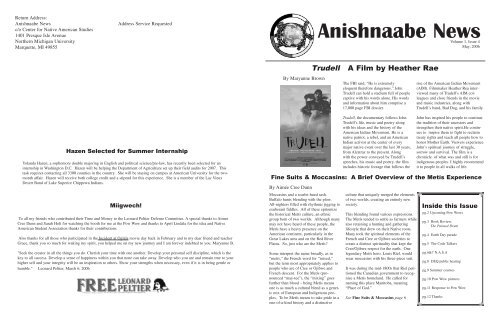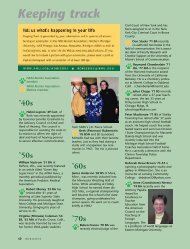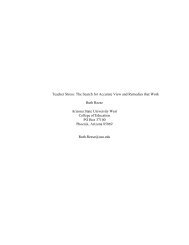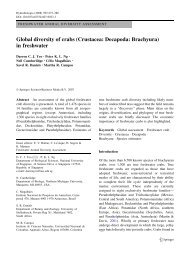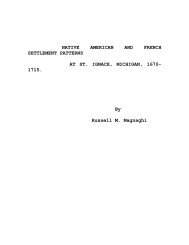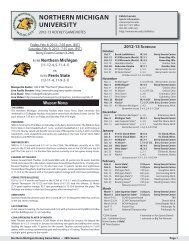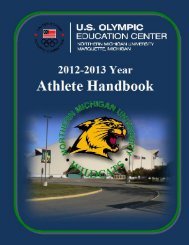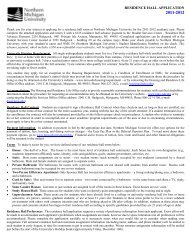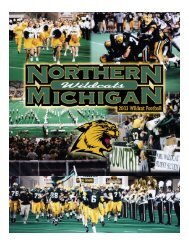You also want an ePaper? Increase the reach of your titles
YUMPU automatically turns print PDFs into web optimized ePapers that Google loves.
Return Address:<br />
Anishnaabe News Address Service Requested<br />
c/o Center for Native American Studies<br />
1401 Presque Isle Avenue<br />
<strong>Northern</strong> <strong>Michigan</strong> <strong>University</strong><br />
Marquette, MI 49855<br />
Hazen Selected for Summer Internship<br />
Yolanda Hazen, a sophomore double majoring in English and political science/pre-law, has recently been selected for an<br />
internship in Washington D.C. Hazen will be helping the Department of Agriculture set up their field audits for 2007. This<br />
task requires contacting all 3300 counties in the country. She will be staying on campus at American <strong>University</strong> for the twomonth<br />
affair. Hazen will receive both college credit and a stipend for this experience. She is a member of the Lac Vieux<br />
Desert Band of Lake Superior Chippewa Indians.<br />
Miigwech!<br />
To all my friends who contributed their Time and Money to the Leonard Peltier Defense Committee. A special thanks to Aimee<br />
Cree Dunn and Sarah Holt for watching the booth for me at the Pow Wow and thanks to April Lindala for the idea and Native<br />
American Student Association thanks for their contributions.<br />
Also thanks for all those who participated in the Incident at Oglala movie day back in February and to my dear friend and teacher<br />
Grace, thank you so much for waking my spirit, you helped me on my new journey and I am forever indebted to you. Maryanne B.<br />
"Seek the creator in all the things you do. Cherish your time with one another. Develop your personal self discipline, which is the<br />
key to all success. Develop a sense of happiness within you that none can take away. Develop who you are and remain true to your<br />
higher self and your integrity will be an inspiration to others. Show your strengths when necessary, even if it is in being gentle or<br />
humble." Leonard Peltier, March 6, 2006<br />
By Maryanne Brown<br />
Anishnaabe News<br />
Volume 1, Issue 4<br />
May, 2006<br />
The FBI said, “He is extremely<br />
eloquent therefore dangerous.” John<br />
Trudell can hold a stadium full of people<br />
captive with his words alone. His words<br />
and information about him comprise a<br />
17,000 page FBI dossier.<br />
Trudell, the documentary follows John<br />
Trudell’s life, music and poetry along<br />
with his ideas and the history of the<br />
American Indian Movement. He is a<br />
native patriot, a rebel, and an American<br />
Indian activist at the center of every<br />
major native event over the last 30 years,<br />
from Alcatraz to the present. Along<br />
with the power conveyed by Trudell’s<br />
speeches, his music and poetry, the film<br />
includes historic footage that follows the<br />
rise of the American Indian Movement<br />
(AIM). Filmmaker Heather Rea interviewed<br />
many of Trudell’s AIM colleagues<br />
and close friends in the movie<br />
and music industries, along with<br />
Trudell’s band, Bad Dog, and his family.<br />
John has inspired his people to continue<br />
the tradition of their ancestors and<br />
strengthen their native spirit.He continues<br />
to inspire them to fight to reclaim<br />
treaty rights and teach all people how to<br />
honor Mother Earth. Viewers experience<br />
John’s spiritual journey of struggle,<br />
sorrow and survival. The film is a<br />
chronicle of what was and still is for<br />
indigenous peoples. I highly recommend<br />
it to people in all walks of life.<br />
Fine Suits & Moccasins: A Brief Overview of the Metís Experience<br />
By Aimée Cree Dunn<br />
Moccasins and a scarlet-hued sash.<br />
Buffalo hunts blending with the plow.<br />
All-nighters filled with rhythmic jigging to<br />
exuberant fiddles. All of these epitomize<br />
the historical Metís culture, an ethnic<br />
group born of two worlds. Although many<br />
may not have heard of these people, the<br />
Metís have a heavy presence on the<br />
American continent, particularly in the<br />
Great Lakes area and on the Red River<br />
Plains. So, just who are the Metís?<br />
Some interpret the name broadly, as in<br />
“metís,” the French word for “mixed,”<br />
but the term most appropriately applies to<br />
people who are of Cree or Ojibwe and<br />
French descent. For the Metís (pronounced<br />
“may-tee”), the “mixing” goes<br />
further than blood – being Metís means<br />
one is as much a cultural blend as a genetic<br />
mix of European and Indigenous peoples.<br />
To be Metís means to take pride in a<br />
one-of-a-kind history and a distinctive<br />
Trudell A Film by Heather Rae<br />
culture that uniquely merged the elements<br />
of two worlds, creating an entirely new<br />
society.<br />
This blending found various expressions.<br />
The Metís tended to settle as farmers while<br />
also retaining a hunting and gathering<br />
lifestyle that drew on their Native roots.<br />
Many took the spiritual elements of the<br />
French and Cree or Ojibwe societies to<br />
create a distinct spirituality that kept the<br />
Cree/Ojibwe respect for the earth. One<br />
legendary Metís hero, Louis Riel, would<br />
wear moccasins with his three-piece suit.<br />
It was during the mid-1800s that Riel petitioned<br />
the Canadian government to recognize<br />
a Metís homeland. He called for<br />
naming this place Manitoba, meaning<br />
“Place of God.”<br />
See Fine Suits & Moccasins page 6<br />
Inside this Issue<br />
pg.2 Upcoming Pow Wows<br />
pg.3 Book Review:<br />
The Painted Drum<br />
pg.4 Earth Day parade<br />
pg.5 The Code Talkers<br />
pg.6&7 N.A.S.A<br />
pg.8 DEQ public hearing<br />
pg.9 Summer courses<br />
pg.10 Pow Wow pictures<br />
pg.11 Response to Pow Wow<br />
pg.12 Thanks
Fine Suits & Moccasins<br />
Continued from page 1<br />
The Canadian government ignored his<br />
petitions and instead sent surveyors to<br />
mark off Metís land for settlement by<br />
Euro-Canadians. This confrontation<br />
brought about the Metís revolutions, led<br />
by Riel. Riel was eventually condemned<br />
by the state as a megalomaniac and an<br />
inciter of insurrection and was hanged.<br />
The Metís still feel his presence and are<br />
certain he continues to help his people<br />
from the spirit world.<br />
The Metís revolutions ended in a widespread<br />
diaspora as the Canadian government<br />
relentlessly tracked the Metís down<br />
in an effort to forestall future rebellions.<br />
Lacking a recognized land-base, denied<br />
status as an Indigenous people by both<br />
the American and Canadian governments,<br />
and forced into hiding after the revolutions,<br />
the Metís fell between the cracks of<br />
society in Canada and, even more so, in<br />
the U.S. Until recently. While the Metís<br />
continue to be a virtually unknown culture<br />
in the U.S., Canada has finally recognized<br />
the Metís as Indigenous peoples<br />
and, within the last few years, has also<br />
recognized aboriginal hunting, gathering<br />
and fishing rights, at least for those who<br />
can prove they come from an “officially”<br />
historical Metís community.<br />
With the international revival of<br />
Indigenous pride in the 1970s, a Metís<br />
cultural revitalization movement also<br />
began. Cultural resource centers have<br />
sprung up in various regions in Canada.<br />
Many strive to maintain the Michif language,<br />
a blending of French and Cree, or<br />
to keep alive the Metís tradition of music<br />
and dance, particularly fiddle music and<br />
jigs. Others work to retell the stories of<br />
Metís heroes such as Riel, Poundmaker,<br />
Big Bear and Gabriel Dumont.<br />
Although the blending between Native<br />
and European cultures is not readily<br />
accepted, the Metís show that blending<br />
can lead to unique cultural possibilities.<br />
Indeed, some may argue that such a<br />
blending is necessary if we are to have a<br />
future where the survival of the earth as<br />
we know it is even possible.<br />
The 14th Annual NMU<br />
“Learning to Walk Together”<br />
Traditional Pow Wow<br />
The Painted Drum<br />
by Louise Erdrich<br />
A Book Review<br />
By Melissa Conner<br />
The sound of the drum is often related to a<br />
heartbeat—a constant reminder of life and<br />
continuance. Louise Erdrich’s novel, The<br />
Painted Drum contains such a pulse that<br />
gives the book both life and rhythm.<br />
When Faye Tavers is hired to appraise the<br />
estate of a late neighbor, she discovers,<br />
among many other artifacts and valuables,<br />
a rare and unique drum. It is beautifully<br />
decorated and is made from moose skin<br />
and cedar. The drum is adorned with symbols<br />
that she does not recognize and radiates<br />
with bright red tassels and beads. Her<br />
fascination of such an original object<br />
increases when she, without touching it,<br />
hears it sound.<br />
Throughout the novel the reader is taken<br />
on a circular journey, going back in time<br />
to learn of the drum’s creation and moving<br />
forward again to New Hampshire, where<br />
the story originally begins. The heartwrenching<br />
creation of the drum, presented<br />
through the stories of Bernard Shaawano,<br />
helps the reader understand how and why<br />
the drum has such a profound impact on<br />
anyone that hears its beat.<br />
Although the drum continues to live<br />
throughout the duration of the novel,<br />
The Painted Drum is a book about death<br />
and mourning. It is full of beautiful language<br />
and images of animals that represent<br />
death, such as the raven and the wolf.<br />
The drum, as it makes its way through<br />
the pages of the novel and the hands of<br />
owners, helps whoever crosses its path<br />
deal with the loss of a loved one.<br />
This novel is not a light read but one that<br />
is to be read slowly so everything can be<br />
absorbed in time. The Painted Drum<br />
beats with wise and thoughtful philosophies<br />
on life, love, and mourning. Erdrich<br />
creates loving characters that many readers<br />
will sympathize with. The circular<br />
movement of the novel is a symbolic representation<br />
of the shape of the drum and<br />
the importance of life as a continuous<br />
journey with no ending point. It serves as<br />
a reminder that no matter what life brings<br />
you, the beat always goes on.<br />
From the Poem<br />
entitled,<br />
"To Dance is To Pray"<br />
By April E. Lindala<br />
III. Feast Time<br />
Sucking salt pork from the steamy hominy<br />
soup.<br />
My wooden bowl filled, overflowing<br />
Licking my lips I relish<br />
sautéd venison with bits<br />
of bacon hand harvested wild rice<br />
with cranberries cashews<br />
and light, flaky fry bread giving me<br />
moist kissable lips from fry<br />
bread grease<br />
black coffee<br />
with too much sugar<br />
savor a swig or two of that coffee<br />
fried whitefish caught only yesterday and<br />
a thick slice of that juicy meatloaf<br />
that juicy, juicy, greasy, greasy meatloaf.<br />
Remember that greasy spill inside oven #2<br />
that caught fire and almost burned down<br />
the tiny kitchen with all of us in it?<br />
potato salad, fruit salad, leafy salad, pasta<br />
salad, tuna salad and that surprise jello<br />
salad<br />
that turned out orange<br />
when we all think it should have been<br />
red.<br />
spaghetti noodles, penne noodles, green<br />
beans, pork and beans<br />
more coffee damn, that's good coffee...<br />
peanut butter cookies, commodity of<br />
course spicy pumpkin<br />
bars with melting whip cream chocolate<br />
cake with white<br />
frosting, a giant bite of gushing summer<br />
watermelon that drips<br />
down my chin.<br />
while managing my mouth<br />
full of laughter<br />
I thank the Creator with each spoonful that<br />
I am here<br />
savoring the<br />
flavors of feast time.<br />
Progressive<br />
Poems<br />
By Shirley Brozzo’s Storytelling<br />
by Native American Women’s<br />
class Winter 2005<br />
Shirley wrote random lines on the board,<br />
and a student wrote the next line.<br />
Then, they folded under the first<br />
line, and passed it on to another<br />
student who responded to the line<br />
they saw, and so forth.<br />
We wake the day<br />
To bless the ancestors<br />
On a sunny day<br />
With birds chirping<br />
With the wind carrying her song<br />
And her song carrying her soul<br />
To lands great and far<br />
Though the lakes my be only be a few<br />
running feet from me<br />
Stars are always above my head<br />
But the markings from the bear end up on<br />
my body<br />
And the bear lives inside of me<br />
I will be true to that spirit, forevermore<br />
I dress in blue<br />
The color of turquiose<br />
Like the waves and sky<br />
The water reflects like a mirror<br />
But not of that that resembles a face<br />
It shows a feeling<br />
Of life’s struggles<br />
Overcoming all obstacles yet unseen<br />
Stumbling along the way, but pushing<br />
orwardIn the darkness with a dim flashlight<br />
travel on, alone<br />
I am the one<br />
Do you hear me?<br />
What do I have to do to make you listen?<br />
To my stories of my people?<br />
My blood will always run through the<br />
rivers<br />
Coursing through the life blood of our<br />
mother<br />
I feel the need to sleep, to dream<br />
To wake up in the morning and feel clean<br />
Is one of the best feelings in the world<br />
To walk with the animal spirits in the<br />
woods<br />
The way Creator intended<br />
10 3
8<br />
DEQ Hears Opposition to Kennecott<br />
By Jay Malchow<br />
On Tuesday, April 18th the <strong>Michigan</strong><br />
Department of Environmental Quality<br />
held hearings on the proposed Kennecott<br />
Mine at <strong>Northern</strong> <strong>Michigan</strong> <strong>University</strong> in<br />
order to take public comments on the<br />
application for the mining permit. It was<br />
reported that an estimated 500 people<br />
attended the hearings, one held in the<br />
afternoon and one held in the evening.<br />
Local television media interviewed two<br />
people at the hearing, one opposed to the<br />
mine, and one in favor of it. These interviews<br />
were aired on that day’s news<br />
broadcast. This was done to highlight reasons<br />
on each side of the opinion regrading<br />
the proposed mine project. What this format<br />
failed to point out is the overwhelming<br />
percentage of people whose comments<br />
were adamantly opposed to the idea of<br />
sulfide mining on the Yellow Dog Plains.<br />
Speaker after speaker expressed<br />
concerns about destruction of the<br />
environment, great volumes of<br />
heavy truck traffic, and high levels<br />
of noise. One speaker who<br />
traveled from Wisconsin and is a<br />
member of the Oneida Nation,<br />
expressed opposition to the proposed<br />
mine in the name of those<br />
who cannot speak out…the<br />
winged-ones, the four-legged<br />
ones, the ones that crawl, the<br />
ones that swim, and human<br />
beings yet unborn.<br />
The DEQ has the authority to either grant<br />
or deny this mining permit. They will<br />
continue to accept comments until<br />
Tuesday, May 16, 2006. To add a comment,<br />
use the contact information listed<br />
below.<br />
E-mail: Steven E. Wilson at<br />
wilsonse@michigan.gov<br />
U.S. mail:<br />
<strong>Michigan</strong> Department of<br />
Environmental Quality<br />
Office of Geological Survey<br />
525 W. Allegan St.<br />
P O Box 30256<br />
Lansing, MI 48909-7756<br />
By Ed Brown<br />
The Code Talkers<br />
Secret coding has been used for many<br />
centuries often during times of war.<br />
Military masterminds have recruited<br />
many talented individuals to code secret<br />
messages that only certain people understand.<br />
During World War II secret coding<br />
was common. The United States<br />
tried numerous methods of coding secret<br />
messages, but the Japanese always deciphered<br />
our codes, until the introduction<br />
of the Navajo language as a coding technique.<br />
In 1942, the vision of one man,<br />
Philip Johnston, became a reality when<br />
he met with Major General Clayton B.<br />
Vogel to convince him of the speed and<br />
accuracy of this new coding process.<br />
The talented Navajo could decipher a<br />
code in 20 seconds, a task of the same<br />
caliber would take a machine nearly 30<br />
minutes to accomplish. The Navajo<br />
coders, dubbed the Code Talkers proved<br />
to be an invaluable asset to the Marines<br />
and to victory in World War II.<br />
The original concept of using the Navajo<br />
language came from Philip Johnston, the<br />
son of a missionary to the Navajos.<br />
Johnston was one of a few non-Navajo<br />
who could speak the language fluently.<br />
After serving in World War I, Johnston<br />
realized how valuable coding was to the<br />
military and he also knew that the<br />
Choctaw language was used during the<br />
war. Johnston believed that the Navajo<br />
language was a perfect vehicle for coding<br />
messages because the language is<br />
complex.<br />
The Navajo language is an unwritten<br />
language. The language is based on<br />
tonal qualities, syntax and dialects, making<br />
it a very difficult language to under-<br />
The Code Talkers<br />
stand without extensive knowledge.<br />
After Johnston staged tests to prove the<br />
speed and accuracy of the code talkers,<br />
Vogel recommended that 200 Navajos be<br />
recruited to the Marines. In the spring of<br />
1942, 29 Navajo recruits attended boot<br />
camp. Those 29 Navajos created the dictionary,<br />
words for military terms and<br />
manuals to decipher the code. During<br />
the training all the code words and the<br />
newly created dictionary must be<br />
memorized.<br />
One Marine officer stated that without<br />
the Navajo code talkers they would have<br />
never taken Iwo Jima. In the first two<br />
days of the battle, the six code talkers<br />
who served under him worked around<br />
the clock to send and receive over 800<br />
messages, all without error. The<br />
Japanese were successful at breaking<br />
previous U.S. codes because an elite<br />
group of soldiers were well trained in<br />
the English language. This elite group<br />
intercepted U.S. messages and either<br />
sabotaged them or relay ed false commands<br />
to ambush<br />
American troops. The<br />
Chief of Intelligence for<br />
Japan was quoted as<br />
saying that they were<br />
able to break all the<br />
codes used by the U.S.<br />
Army and Air Corps, but<br />
they were never able to<br />
break the Navajo code<br />
used by the Marines.<br />
Up to 1945 about 540<br />
Navajos served as<br />
Marines and of those<br />
about 400 trained as<br />
code talkers. The code<br />
remained quite valuable<br />
even after the war,<br />
resulting in a delay of<br />
celebration and praise for<br />
the code talkers. The code was finally<br />
declassified 23 years after the war<br />
ended. In 1968 the secret was finally<br />
released. Do to the high confidentiality<br />
of the code, all of the code talkers took<br />
an oath of secrecy. The high level of<br />
secrecy meant that all of the soldiers that<br />
committed themselves to serving as code<br />
talkers were not able to be recognized.<br />
For them, there were no parades when<br />
they came home, nothing written in<br />
books, no news stories, no congratulations<br />
of any sort. Finally after the secret<br />
was declassified, the Navajo code talkers<br />
recieved the recognition they so rightfully<br />
deserved.<br />
Technique<br />
When the code come through it would<br />
sound like a barrage of unrelated Navajo<br />
words to the untrained ear. What the<br />
translator had to do was take each<br />
Navajo word and convert it into its<br />
English meaning. With the English<br />
word now revealed, the code talkers take<br />
the first letter from each newly translated<br />
word and spelled out the message. An<br />
example follows:<br />
“The Navajo words “wol-la-chee” (ant),<br />
“be-la-sana” (apple) and “tse-nill” (axe)<br />
all stood for the letter “a.” One way to<br />
say the word “Navy” in Navajo code<br />
would be “tsah (needle) wol-la-chee<br />
(ant) ah-kehdi-<br />
glini (victor)tsah-ahdzoh<br />
(yucca).”’<br />
When the<br />
original<br />
developers of<br />
the secret<br />
code were<br />
constructing<br />
it, they commonly<br />
used<br />
military<br />
terms and<br />
assigned<br />
Navajo<br />
words to<br />
them, about<br />
450 in total. Some examples are:<br />
“besh- lo” (iron fish) meant “submarine,”<br />
“dah-he- tih-hi” (hummingbird)<br />
meant “fighter plane” and “debeh-lizine”<br />
(black street) meant “squad.”<br />
See Code Talkers page 9<br />
5


